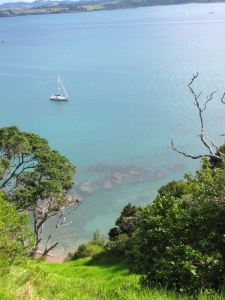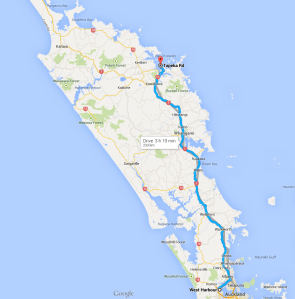 We decided it was time to explore some of the Northland and planned a week long trip where we’d be spending 3 nights in the Bay of Islands and then 3 nights in Ahipara.
We decided it was time to explore some of the Northland and planned a week long trip where we’d be spending 3 nights in the Bay of Islands and then 3 nights in Ahipara.
Our journey started with a 3½ hour drive from Auckland to Tapeka Point in the Bay of Islands, this included a first-time trip on a car ferry, from Opua to the quaint little town of Russell. The car ferry was quick, only taking 10 minutes (there is also passenger ferry that runs from Paihia to Russell, which can be used if you’re heading out to explore and don’t need a vehicle).
Formerly known as Kororāreka, Russell was the first permanent European settlement and New Zealand’s first capital. With whaling becoming a major industry in the 1800’s, the town quickly became known as the “hellhole of the Pacific”, thanks to the rough and rowdy crews off the ships docked in port.
Trade between the local Māori and the Europeans flourished, although it wasn’t always favorable. The trade of muskets in the early 1820’s led to “The Musket Wars”, where old feuds between Māori tribes were settled with these new, powerful and destructive weapons. Many were killed, with certain Māori tribes being destroyed completely and the boundaries of original tribal lands altered.
Situated along the waterfront road, in the town of Russell, is the Duke of Marlborough Hotel. We have been watching MasterChef on TV and a few weeks before we arrived, the contestants had been given the opportunity to cook in this ‘history-steeped’ hotel!
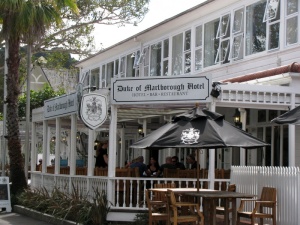
Duke of Marlborough Hotel
To give you an idea of the history surrounding this place, this next section is an extract from http://www.theduke.co.nz: “The Duke of Marlborough began its life in 1827 as “Johnny Johnstons Grog Shop”. The owner Johnny Johnston was an ex convict come good, he became fluent in Te Reo and was very well regarded with the local Maori. This relationship led to Johnny being able to purchase the freehold site of the Duke – which was one of the first land sales to a European in New Zealand.
In the 1830s, Russell or Kororareka, as it was known then, was the biggest whaling port in the Southern Hemisphere and turned out to be a bit of an eye opener for the missionaries. Up to 500 whalers at a time would arrive in Russell after twelve months at sea, with Russell having no effective law enforcement agency, the scene wasn’t ideal. Prostitution was one of the area’s largest industries and many local women frequently entered into 3 week marriages.
Johnny quickly changed the name of his hotel to the Duke of Marlborough, at the time the Duke of Marlborough was the world’s richest man, so the name sought to bring respect, elegance and opulence to the “Hell Hole of the Pacific”. By all accounts, Johnny was a well trusted man and assisted in the translation of the treaty of Waitangi to the Maori – it is rumoured he was worried that the Maori version did not quite equate to the English version (it still pays to listen to your publican!)
After the Treaty of Waitangi in 1840, New Zealands first government was formed just down the road in Okaito, and started treating to bring the famed lawlessness to an end. With Johnny being so well known in the local area, it is no surprise that he managed to swing the very first licence for his establishment (the colonial treasurer was a close friend), so after 13 years of serving Whalers, traders and prostitutes, Johnny the ex-con was now all legal. The licence now hangs proudly in a gold frame in the bar, where sharp eyed history buffs have pointed out a reference to the succession of Queen Victoria from her father.”

ex-Russell Police Station
Walking a little further up the road from the Duke of Marlborough, we got to see the large old Morton Bay Fig tree and a very old house that used to be Russell’s Police Station. The sign outside the house reads as follows:
“ex-Russell Police Station. This Historic House was designed by W.H. Clayton, the Colonial Architect in the late 1860’s. First occupied in 1870, it served as a custom house until the 1890’s. It became a Police Station and residence in the early 1900’s.
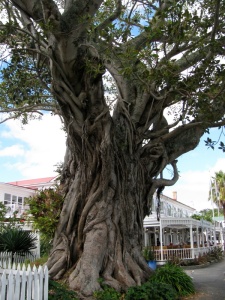
Morton Bay Fig Tree (planted between 1870 & 1886)
The adjacent Morton Bay Fig Tree (Ficus macrophyllia) was planted by the first collector of customs … Mr E.B. Laing who served from 1870 to 1886. This house is the Policeman’s home, please respect his privacy.”
To read more interesting facts on the history of Russell and to continue reading about The Duke of Marlborough, visit http://www.russellnz.co.nz/russell-history and http://www.theduke.co.nz
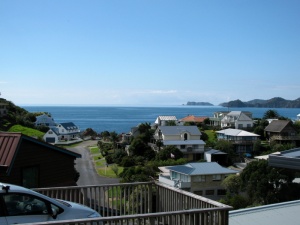 Our “home” for the three days spent in Tapeka Point, was a rented bach (pronounced ‘batch’, which is an NZ holiday home) situated about 2kms from the town of Russell. Tapeka Point consists of a large hill jutting out between two bays, with spectacular views stretching from Paihia and Waitangi and then sweeping out across the Bay of Islands. The walk up the hill can be a little steep at times and I wouldn’t recommend walking up there directly after a heavy rain or in the drizzle, as the grass and muddy slopes can get quite slippery, but on a clear sunny day, the climb is not too bad and the awesome views are definitely worth the effort!
Our “home” for the three days spent in Tapeka Point, was a rented bach (pronounced ‘batch’, which is an NZ holiday home) situated about 2kms from the town of Russell. Tapeka Point consists of a large hill jutting out between two bays, with spectacular views stretching from Paihia and Waitangi and then sweeping out across the Bay of Islands. The walk up the hill can be a little steep at times and I wouldn’t recommend walking up there directly after a heavy rain or in the drizzle, as the grass and muddy slopes can get quite slippery, but on a clear sunny day, the climb is not too bad and the awesome views are definitely worth the effort!
